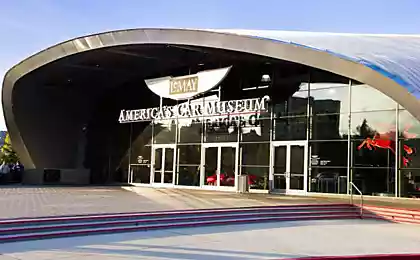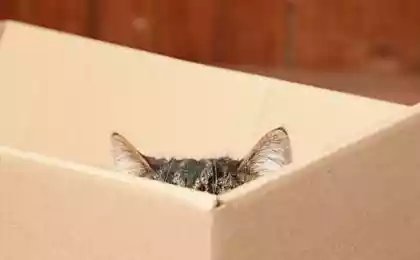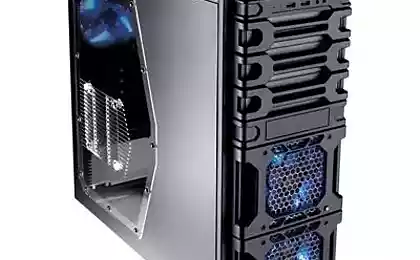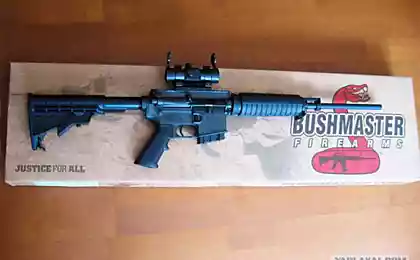3049
Tobacco Box
Papa put on the table snuffbox. "Come here, Misha, look," he said. Misha was a good boy; immediately left the toys and went to papa. Yeah, and it was something to see! What a great snuff-box! pestrenkaya of turtles. And that on the cover of something! Gates, towers, house, two, three, four - and can not find it, and all smaller than the other, and all the gold; trees and a well as gold and silver leaf on them; as the sun rises behind the trees, and from the pink rays diverge across the sky. © Odoyevski "town in snuffbox»

It all began in the XVI century, when the French ambassador Jean Nicot sent to the Queen of France Catherine de 'Medici, who suffer from migraines, popular in Portugal snuff snuff. It was believed that tobacco if its smell, cures migraine. And helped! When the son of Catherine Francis II smelling tobacco becomes a fashion, and under Louis XIV part of court etiquette. Naturally, this hobby is not spared and Russia. Luxury grandee of Catherine's court treated each other tobbacco snuff and snuff became a kind of jewelry. Produced musical snuff boxes, which played popular tunes at opening. Snuffbox penetrated into the life of a variety of populations. Even Steadfast Tin Soldier in Andersen's fairy tale admiring the beautiful dancer, leaning against a snuffbox on the table.
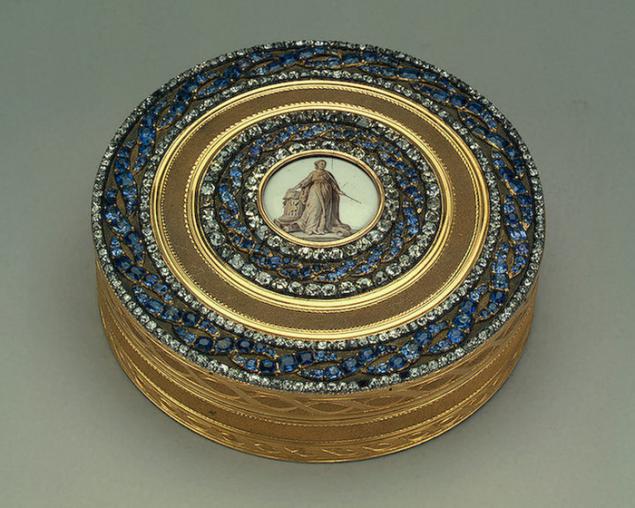
XVIII century was the century of a truly snuff. Prussian King Frederick the Great in 1740, he inherited 600 such small boxes, and after 46 years has left behind for about one and a half thousand. Prince Conti had 800 snuff. The numbers are impressive: a collection can boast only major museums! And the thing is that every change of dress required by the mod change snuff. Used for the manufacture of a variety of materials: gold and precious stones, aluminum (at the time tsenivshiysya than gold) and steel, tortoise shell and sharkskin (galyusha), porcelain and elm.
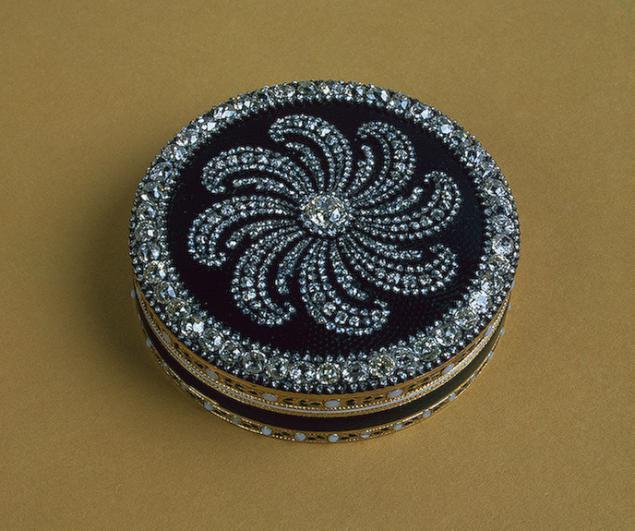
At the Russian court decided was to use snuff-boxes of precious metals, and only in the reign of Elizabeth (1741-1761) made significant competition porcelain snuff. It is significant that the first Russian porcelain, created at the Imperial Porcelain Factory in 1752, it became a snuffbox. These were the famous "Pugs". Connected with them very interesting story!

The most numerous buyers porcelain from the late 1730s were Masons. When in 1738 the Pope forbade Catholics to join the brotherhood of "Freemasons" Masons began to unite in secret lodges. But in order to get to know "their", they needed a secret sign. Miniature snuffbox was ideal for this role. It fits in your pocket, and it could be removed at any time, without arousing suspicion from outsiders. A password was Meissen figurines with pug.

Snuffbox firmly established in the life of people of different classes. As a consequence, it becomes an indispensable accessory costume is part of the headset jewelry. And not just the costume. Containers for tobacco was inserted into the armrests and even handle canes.
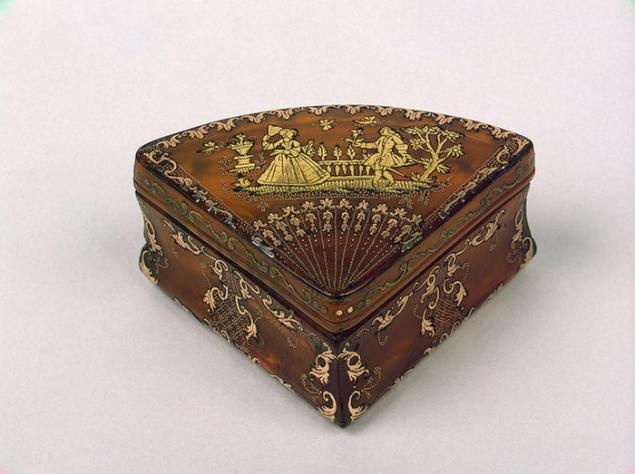
It is not surprising that such devotion owner and proximity to him did snuffbox accomplice in the most delicate plants. A special place is occupied logged into fashion in the form of snuff-boxes sealed mail package. They served as an envelope for the letter and case for the generous gift. In 1791, already at sunset century snuff in "correspondence fashion" stated: "... We serve a hidden kibitochkoyu in which red tape sends his letters, love nonsense, romantic imagination, for snuff many women and girls perpetrate the now more than a kibitochkami love mail ".
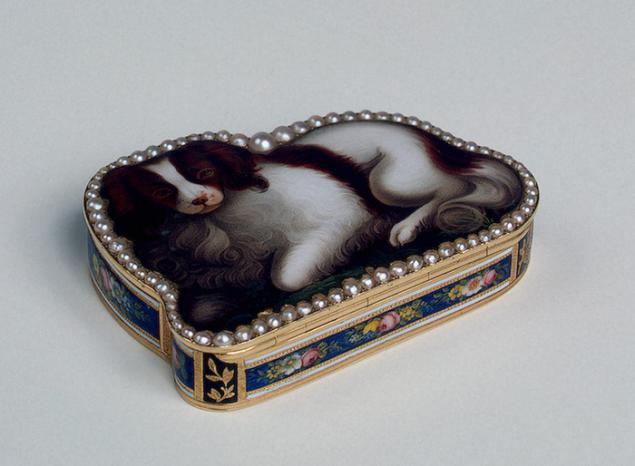
For fans of different types of tobacco were invented multipart-box, in which each department shut the lid. These boxes were used for secret mail. To be able to open a branch office lady friend, and another - for her husband, snuff boxes were made by bilateral. The same construction as the best suited for misers, who preferred to treat other tobbacco poploshe.
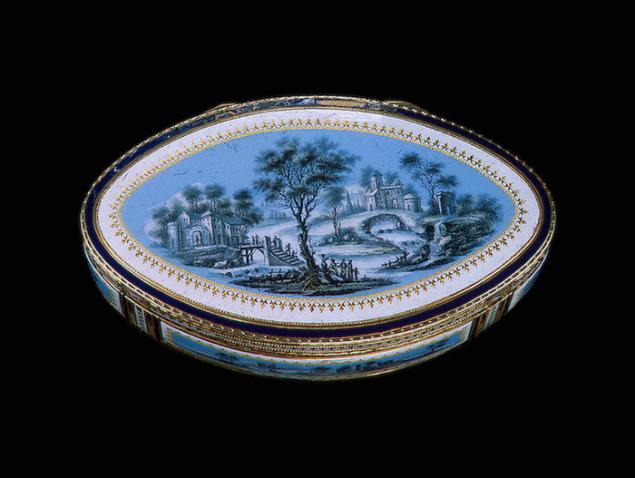
Paketovye snuff in form and decoration were similar to the folded letter - a package (because the envelope at the time was not). Such snuff boxes were made of porcelain and enamel, white color which resembles plain paper. On the upper side of the cover flat black boxes inscribed Address: sometimes specific, sometimes conditional, such as "lovely brunette in St. Petersburg." Red and blue, imitating mail services, applied the mark, as in the present letter. Simulated and SEAL sheet. The message in such a package could be poetry or miniature portrait.

Developed and certain rules of etiquette associated with snuff. At the meeting it was considered an act of courtesy to offer the other party an open snuffbox. The highest expression of generosity, the most eloquent friendly gesture - was the exchange of snuff. So, Laurence Sterne, one of the founders of sentimental literature at the beginning of his "Sentimental Journey Through France and Italy" (1768), put a special chapter "Snuff-box." Mutual treat tobacco beggar French monk and travels English gentleman and was a sign of their reconciliation, and a symbol of harmonization of state of mind. Moreover, the difference in social status of heroes is the author emphasized using snuff: horn and tortoiseshell.

By the way, snuff boxes, decorated with enamel and diamonds, with the imperial monogram were even kind of state awards. Twice received a gift Derzhavin, it is as a poet, not as a lord of the ode "Felitsa" and "On the capture of Ishmael." Another celebrity of the era Basil Kapnist received a snuffbox with the monogram of the Empress, showered with diamonds, for an ode against slavery. And when traveling to the south of Catherine of Russia Alexander Suvorov received a snuffbox with gold coins worth 7,000 rubles.
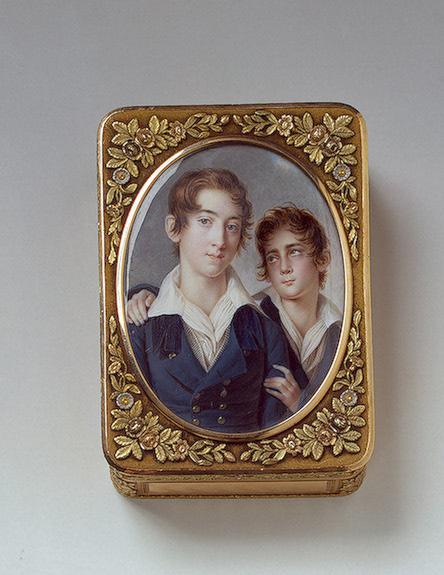
Being decorated with a portrait of the reigning monarch, snuff valued above Order, for "merit" took precedence over "differences." "Below the rank of" standing snuffbox with the monogram of the monarch.

However, snuff, prepodnesёnnaya as a gift, had a different semantic meaning, namely, to retire from sight. Marquise de Pompadour once did not want to take the boring lover and after he sent a servant to snuff. It depicted Cupid struck by an arrow (symbol of love who died), and the inscription: "Enough." Paul I gave snuffbox as a wedding gift has not yet reached the peak of fame Pyotr Bagration. Gossips claimed that the non-secular military, thus making an allusion to the need to leave the yard, leaving a beautiful wife ...

Certain subtext was snuffbox, presented by Nicholas I the Dutch ambassador Baron Heeckeren. After the tragic duel his adopted son Dantes with Baron Alexander Pushkin was not accepted by the emperor. The Emperor sent him without comment precious snuffbox. The court explained puzzled foreigner meaning of a gift: a diplomat in Russia has become persona non grata, and seeing him do not want to continue.

The decor snuff often enclosed theme of the game, particularly common motive of love flirting. Even banal flowers were devoted to an exciting message: Rose - recognition of beauty, forget-me-- Pledge of Allegiance, tulip - a marriage proposal or bragging. Yes, and genre scenes, where ladies and gentlemen play music, walk, talk, often have additional meaning. For example, fishing for bait traditionally meant a love game, flirting.
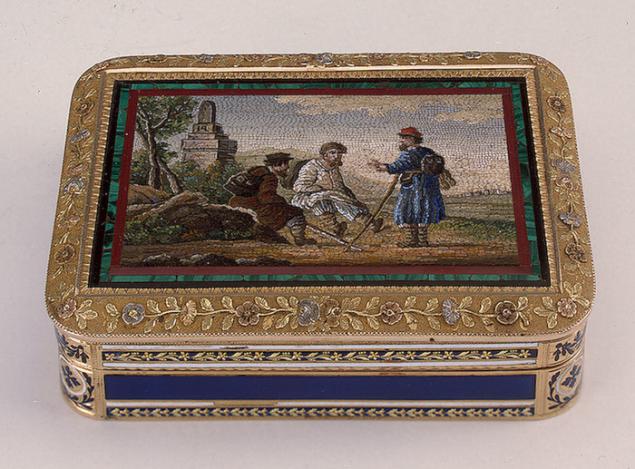
Differently reflected in the decor theme snuff road or way of life: snuff-coach, snuff-boats, snuff boxes, chests (it could be a trunk, which was attached to the outside of the crew, and could be podgolovok - chest for the most valuable belongings, which is night put under the pillow). Boat on the lake, sail in the sea, a wreath on a tree branch, the obelisk on the hill - all these symbolic images do not require a clue and are understood by the influence of classic contemporary art.

Comical scenes depicted on the covers of snuff, sometimes passed in a political pamphlet, violated the scope of decency. And discussed seriously at the highest level. In nominal decree Empress Elizabeth, was read to the Senate the Attorney-General Prince Trubetskoy, was commanded to "prohibit the sale and resale pashkvilnye" snuff. In case involved the College of Commerce and the Office of the metropolitan police chief. But contrary to the will of the Empress two snuff with political satire - "Europe is sitting under a canopy, sad, and in front of her cardinal with weights, step on the sheet" Balance of Europe "and" Cardinal sits with a cane on the table before him Card "I share the empire" - Senators were not recognized "pashkvilnymi."
In the last decade gallant century becomes fashionable accurately depict the corners of nature, dear sensitive hearts of their respective owners. Count Stroganov in the 1790s, placed under glass snuff made as early as 1755-1756 years in France Parisian craftsman Jean Dyukrolle, six kinds of miniatures with his suburban garden and park.
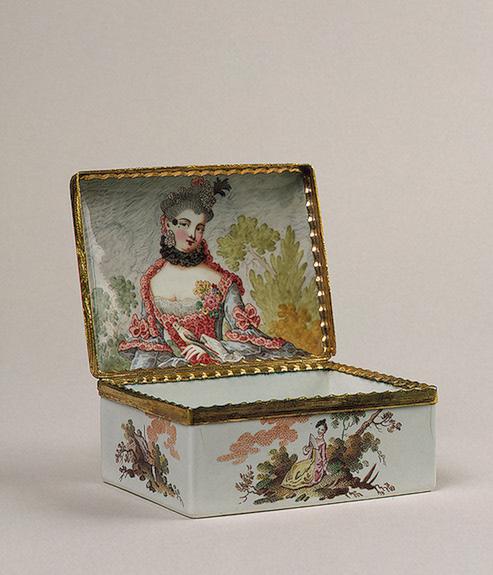
On the exotic Chinese Pavilion in Tsarskoye Selo recalls ordered by Catherine II gold snuffbox with diamonds worth 2750 rubles (jeweler Gottfried Goebel, 1779). And in the 1790s, Catherine II Styling Award snuffbox decorated with views of the park facilities that are associated with rewarding individuals. Brothers Claude and Francois-Pierre Etienne Theremin, who owned a small ware factory in St. Petersburg, twice (1795 and 1796) performed a similar order of the Empress. On account of July 12, Secretary of State added: "One snuffbox left in Her Majesty with a monument of Count Orlov Chesmensky, the other is the same Chesmensky granted to Count Orlov, the third gene is presented. Major Count Nikolai Zubov with a colonnade of the Tsarskoye Selo. "

On the occasion of the "sea victories won in the Archipelago" in 1770, Count AG Orlov-Chesmensky was sent snuffbox cost 250 rubles, followed by an autograph letter autocrat of 19 July 1795 inscribed in Tsarskoye Selo: "Count Alexey Grigoryevich. In the sign of My favor to you, send you a snuffbox. Her whole price is the image of the monument, which is the glory of your homeland and znamenityya merit your evidence. " Next Empress added: "I would snuffbox spread ground tobacco growing in my garden, now is not a sniff, but I am afraid that the roads dry up."
Orlov was immensely happy that the 25th anniversary of the glorious sea Victoria his services were not forgotten, and immediately wrote a thanksgiving answer. After receiving it, the empress did not hesitate to answer: "Count Alexey Grigoryevich. Your letter, dated July 30, this time to my hands delivered. From thereof see that snuffbox me sent to you, please you; that I wanted. Catherine. Desired tobacco grown in my garden, the bank will send. "
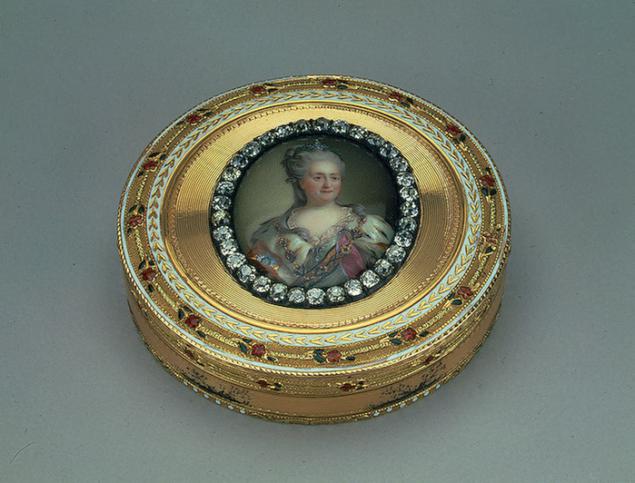
Unfortunately, the graph of the snuffbox, known contemporaries Le Balafre, that is "tagged" because Orlov received in his youth a scar on his cheek, nothing more is known.
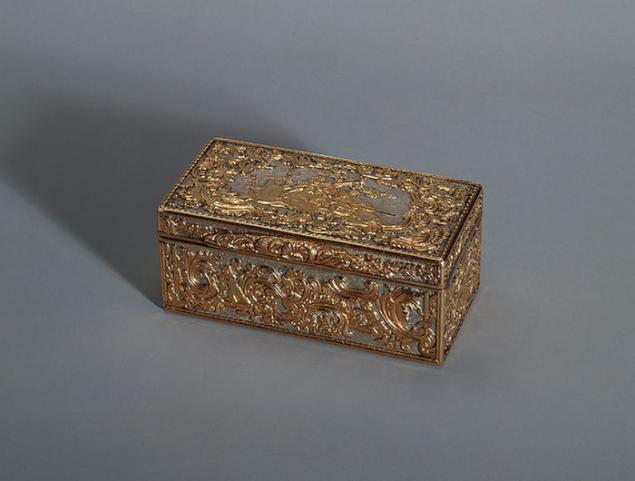
But exposure Armory decorated gift of Catherine II to her favorite Count Nikolay Zubov. On the cover of a large octagonal-box, with blue enamel, written form of the Cameron Gallery, is a favorite summer residence of the Empress area.

She thought over how to decorate a gallery bronze busts of famous ancient philosophers, poets, political and military leaders, and turn it into a kind of temple of fame, which has become a favorite place not only walks autocrat, but also all kinds of court holidays.
Tobacco is so entered into the life of society, that the description of some ordinary events from the classics of literature very often accompanied by the mention of a tube or snuff. NV Gogol, describing the house landlord middling, writes: "tube: wood, clay, meerschaum, smoked and neobkurennye covered with suede and neobtyanutye then - recently won his pipe, tobacco pouch embroidered a sort of Countess."

Manilow smoking a pipe with a shank and tobacco in his house was in caps (paper bag) and tabachnitse, and finally poured a heap on the table. Chichikov snuff-box with a secret, and he was even some discussion with Manilov that "smoke a pipe is much healthier than snuff" snuff-box was so commonplace among gamblers that VI Dahl writes, as it was used in shulerskih game: "Who throws, puts more snuffbox, spread syspodu sticky on deck, pulling a handkerchief at this time, and by removing the snuffbox, carries with it the map."

But there were snuff and simpler. In Russia, their mass production began in 1795. Why would you think? With the production of lacquers visors hat uniforms of the Russian army. Moscow merchant PI Boxes in the village of Danilkovo (now Fedoskino) founded the factory. Brought several artists from the German city of Braunschweig with the famous lacquer factory I. Shtobvassera and through them established at the production of lacquer snuff and other products made of papier-mache.
These were boxes decorated with simple ornaments and snuff, which is glued to the cover-paper pictures gravyurki topped with a light varnish. The pictures usually depict events of recent history - episodes of the war of 1812, military operations against the Turks.

Sometimes snuff became the center of detective work, helping to return the names consigned to the past. One of these snuff is in the State Historical Museum. It has created Jacob Moses, profile portrait depicting military. Initially decided that snuffbox shows MI Kutuzov. The first attribution was soon rejected as an anchor on the collar of his uniform pointed to a naval officer, namely, Admiral. Later in the inventory card this thing were the names of the first marine minister Count NS Mordvinova and head of the censorship department, the Minister of Education Vice Admiral AS Shishkov.

Museums around the world keep old snuff boxes and tubes.
In Uzbekistan, a special popularity gained snuff, which were manufactured from specially grown pumpkins. Uzbek snuffboxes vary in shape, size, the nature of finishes. Making them related to the complex process of dyeing, patterned toning and polishing, finishing with noble metal and colored stones.

In the Chukchi regional museum stores handbag-snuffbox of reindeer fur, and the northern city of Aksha Museum - snuff box made of birch bark, in African museums - snuff boxes, beaded.

In Denmark, there is a unique museum in the world of tobacco. Curious museum exhibit - snuffbox from sperm whale tooth, made in 1750 in Iceland.
This exhibit, in addition to its antiquity is still different beauty care finishes, there is still, perhaps, the dimensions. Its length of 18 cm.
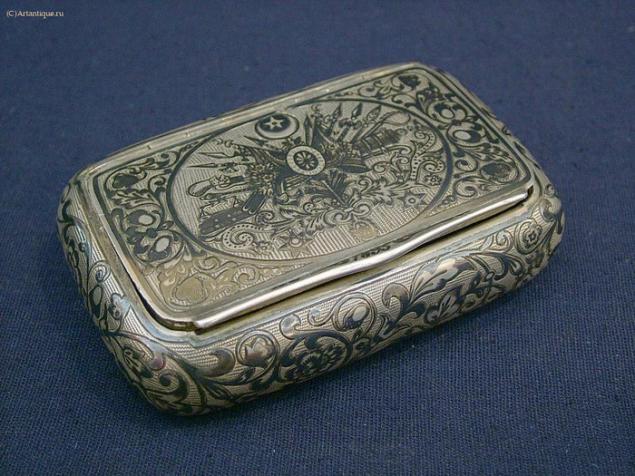
Interested in the history of snuff-boxes and in Asia. Especially helped to spread to the East snuff Jesuit missionaries, who were in the XVII century are very influential at the court of Emperor Manchu dynasty. Imperial Court smoothly gets ready to snuff out of Europe. Engaged in the supply of the Portuguese settled in Macau.

In 1685, snuff was first mentioned among the imported goods, and soon in the capital of China begins its own production. In Beijing - exclusively for the imperial court - produced snuff with special healing and antibacterial properties. It was stored in glass jars, bottles, breathed in each nostril with a small spatula of ivory.

In China, the production of glass bottles born-snuff. They are decorated with enamel on metal and glass, used porcelain, jade, jade, crystal or amber and exotic materials: bamboo, coconut and tangerine peel.

The history of Chinese glass snuff bottles, truly amazing. One of the earliest copies of the dated and signed by 1646. "Did Zhen Ronchzhan in the second year of the reign of Emperor Shunzhi." Another early bottle refers to 1653. It made the master Zheng Tszunchzhan, and it is stored at the Chicago Museum of Natural History. Truly magnificent Chinese snuff Qing Dynasty (1644-1912 gg.).

Qin Emperor Shenchzhu, who ruled from 1662 to 1722 under the motto - "prosperous and radiant", was a contemporary of Emperor Peter I, he patronized the European style in the applied arts. By 1680, he organized several workshops in Beijing. The art of enameling Chinese masters taught the Jesuits and the French master - which is why some bottles marked a clear European influence.

Source:

It all began in the XVI century, when the French ambassador Jean Nicot sent to the Queen of France Catherine de 'Medici, who suffer from migraines, popular in Portugal snuff snuff. It was believed that tobacco if its smell, cures migraine. And helped! When the son of Catherine Francis II smelling tobacco becomes a fashion, and under Louis XIV part of court etiquette. Naturally, this hobby is not spared and Russia. Luxury grandee of Catherine's court treated each other tobbacco snuff and snuff became a kind of jewelry. Produced musical snuff boxes, which played popular tunes at opening. Snuffbox penetrated into the life of a variety of populations. Even Steadfast Tin Soldier in Andersen's fairy tale admiring the beautiful dancer, leaning against a snuffbox on the table.

XVIII century was the century of a truly snuff. Prussian King Frederick the Great in 1740, he inherited 600 such small boxes, and after 46 years has left behind for about one and a half thousand. Prince Conti had 800 snuff. The numbers are impressive: a collection can boast only major museums! And the thing is that every change of dress required by the mod change snuff. Used for the manufacture of a variety of materials: gold and precious stones, aluminum (at the time tsenivshiysya than gold) and steel, tortoise shell and sharkskin (galyusha), porcelain and elm.

At the Russian court decided was to use snuff-boxes of precious metals, and only in the reign of Elizabeth (1741-1761) made significant competition porcelain snuff. It is significant that the first Russian porcelain, created at the Imperial Porcelain Factory in 1752, it became a snuffbox. These were the famous "Pugs". Connected with them very interesting story!

The most numerous buyers porcelain from the late 1730s were Masons. When in 1738 the Pope forbade Catholics to join the brotherhood of "Freemasons" Masons began to unite in secret lodges. But in order to get to know "their", they needed a secret sign. Miniature snuffbox was ideal for this role. It fits in your pocket, and it could be removed at any time, without arousing suspicion from outsiders. A password was Meissen figurines with pug.

Snuffbox firmly established in the life of people of different classes. As a consequence, it becomes an indispensable accessory costume is part of the headset jewelry. And not just the costume. Containers for tobacco was inserted into the armrests and even handle canes.

It is not surprising that such devotion owner and proximity to him did snuffbox accomplice in the most delicate plants. A special place is occupied logged into fashion in the form of snuff-boxes sealed mail package. They served as an envelope for the letter and case for the generous gift. In 1791, already at sunset century snuff in "correspondence fashion" stated: "... We serve a hidden kibitochkoyu in which red tape sends his letters, love nonsense, romantic imagination, for snuff many women and girls perpetrate the now more than a kibitochkami love mail ".

For fans of different types of tobacco were invented multipart-box, in which each department shut the lid. These boxes were used for secret mail. To be able to open a branch office lady friend, and another - for her husband, snuff boxes were made by bilateral. The same construction as the best suited for misers, who preferred to treat other tobbacco poploshe.

Paketovye snuff in form and decoration were similar to the folded letter - a package (because the envelope at the time was not). Such snuff boxes were made of porcelain and enamel, white color which resembles plain paper. On the upper side of the cover flat black boxes inscribed Address: sometimes specific, sometimes conditional, such as "lovely brunette in St. Petersburg." Red and blue, imitating mail services, applied the mark, as in the present letter. Simulated and SEAL sheet. The message in such a package could be poetry or miniature portrait.

Developed and certain rules of etiquette associated with snuff. At the meeting it was considered an act of courtesy to offer the other party an open snuffbox. The highest expression of generosity, the most eloquent friendly gesture - was the exchange of snuff. So, Laurence Sterne, one of the founders of sentimental literature at the beginning of his "Sentimental Journey Through France and Italy" (1768), put a special chapter "Snuff-box." Mutual treat tobacco beggar French monk and travels English gentleman and was a sign of their reconciliation, and a symbol of harmonization of state of mind. Moreover, the difference in social status of heroes is the author emphasized using snuff: horn and tortoiseshell.

By the way, snuff boxes, decorated with enamel and diamonds, with the imperial monogram were even kind of state awards. Twice received a gift Derzhavin, it is as a poet, not as a lord of the ode "Felitsa" and "On the capture of Ishmael." Another celebrity of the era Basil Kapnist received a snuffbox with the monogram of the Empress, showered with diamonds, for an ode against slavery. And when traveling to the south of Catherine of Russia Alexander Suvorov received a snuffbox with gold coins worth 7,000 rubles.

Being decorated with a portrait of the reigning monarch, snuff valued above Order, for "merit" took precedence over "differences." "Below the rank of" standing snuffbox with the monogram of the monarch.

However, snuff, prepodnesёnnaya as a gift, had a different semantic meaning, namely, to retire from sight. Marquise de Pompadour once did not want to take the boring lover and after he sent a servant to snuff. It depicted Cupid struck by an arrow (symbol of love who died), and the inscription: "Enough." Paul I gave snuffbox as a wedding gift has not yet reached the peak of fame Pyotr Bagration. Gossips claimed that the non-secular military, thus making an allusion to the need to leave the yard, leaving a beautiful wife ...

Certain subtext was snuffbox, presented by Nicholas I the Dutch ambassador Baron Heeckeren. After the tragic duel his adopted son Dantes with Baron Alexander Pushkin was not accepted by the emperor. The Emperor sent him without comment precious snuffbox. The court explained puzzled foreigner meaning of a gift: a diplomat in Russia has become persona non grata, and seeing him do not want to continue.

The decor snuff often enclosed theme of the game, particularly common motive of love flirting. Even banal flowers were devoted to an exciting message: Rose - recognition of beauty, forget-me-- Pledge of Allegiance, tulip - a marriage proposal or bragging. Yes, and genre scenes, where ladies and gentlemen play music, walk, talk, often have additional meaning. For example, fishing for bait traditionally meant a love game, flirting.

Differently reflected in the decor theme snuff road or way of life: snuff-coach, snuff-boats, snuff boxes, chests (it could be a trunk, which was attached to the outside of the crew, and could be podgolovok - chest for the most valuable belongings, which is night put under the pillow). Boat on the lake, sail in the sea, a wreath on a tree branch, the obelisk on the hill - all these symbolic images do not require a clue and are understood by the influence of classic contemporary art.

Comical scenes depicted on the covers of snuff, sometimes passed in a political pamphlet, violated the scope of decency. And discussed seriously at the highest level. In nominal decree Empress Elizabeth, was read to the Senate the Attorney-General Prince Trubetskoy, was commanded to "prohibit the sale and resale pashkvilnye" snuff. In case involved the College of Commerce and the Office of the metropolitan police chief. But contrary to the will of the Empress two snuff with political satire - "Europe is sitting under a canopy, sad, and in front of her cardinal with weights, step on the sheet" Balance of Europe "and" Cardinal sits with a cane on the table before him Card "I share the empire" - Senators were not recognized "pashkvilnymi."
In the last decade gallant century becomes fashionable accurately depict the corners of nature, dear sensitive hearts of their respective owners. Count Stroganov in the 1790s, placed under glass snuff made as early as 1755-1756 years in France Parisian craftsman Jean Dyukrolle, six kinds of miniatures with his suburban garden and park.

On the exotic Chinese Pavilion in Tsarskoye Selo recalls ordered by Catherine II gold snuffbox with diamonds worth 2750 rubles (jeweler Gottfried Goebel, 1779). And in the 1790s, Catherine II Styling Award snuffbox decorated with views of the park facilities that are associated with rewarding individuals. Brothers Claude and Francois-Pierre Etienne Theremin, who owned a small ware factory in St. Petersburg, twice (1795 and 1796) performed a similar order of the Empress. On account of July 12, Secretary of State added: "One snuffbox left in Her Majesty with a monument of Count Orlov Chesmensky, the other is the same Chesmensky granted to Count Orlov, the third gene is presented. Major Count Nikolai Zubov with a colonnade of the Tsarskoye Selo. "

On the occasion of the "sea victories won in the Archipelago" in 1770, Count AG Orlov-Chesmensky was sent snuffbox cost 250 rubles, followed by an autograph letter autocrat of 19 July 1795 inscribed in Tsarskoye Selo: "Count Alexey Grigoryevich. In the sign of My favor to you, send you a snuffbox. Her whole price is the image of the monument, which is the glory of your homeland and znamenityya merit your evidence. " Next Empress added: "I would snuffbox spread ground tobacco growing in my garden, now is not a sniff, but I am afraid that the roads dry up."
Orlov was immensely happy that the 25th anniversary of the glorious sea Victoria his services were not forgotten, and immediately wrote a thanksgiving answer. After receiving it, the empress did not hesitate to answer: "Count Alexey Grigoryevich. Your letter, dated July 30, this time to my hands delivered. From thereof see that snuffbox me sent to you, please you; that I wanted. Catherine. Desired tobacco grown in my garden, the bank will send. "

Unfortunately, the graph of the snuffbox, known contemporaries Le Balafre, that is "tagged" because Orlov received in his youth a scar on his cheek, nothing more is known.

But exposure Armory decorated gift of Catherine II to her favorite Count Nikolay Zubov. On the cover of a large octagonal-box, with blue enamel, written form of the Cameron Gallery, is a favorite summer residence of the Empress area.

She thought over how to decorate a gallery bronze busts of famous ancient philosophers, poets, political and military leaders, and turn it into a kind of temple of fame, which has become a favorite place not only walks autocrat, but also all kinds of court holidays.
Tobacco is so entered into the life of society, that the description of some ordinary events from the classics of literature very often accompanied by the mention of a tube or snuff. NV Gogol, describing the house landlord middling, writes: "tube: wood, clay, meerschaum, smoked and neobkurennye covered with suede and neobtyanutye then - recently won his pipe, tobacco pouch embroidered a sort of Countess."

Manilow smoking a pipe with a shank and tobacco in his house was in caps (paper bag) and tabachnitse, and finally poured a heap on the table. Chichikov snuff-box with a secret, and he was even some discussion with Manilov that "smoke a pipe is much healthier than snuff" snuff-box was so commonplace among gamblers that VI Dahl writes, as it was used in shulerskih game: "Who throws, puts more snuffbox, spread syspodu sticky on deck, pulling a handkerchief at this time, and by removing the snuffbox, carries with it the map."

But there were snuff and simpler. In Russia, their mass production began in 1795. Why would you think? With the production of lacquers visors hat uniforms of the Russian army. Moscow merchant PI Boxes in the village of Danilkovo (now Fedoskino) founded the factory. Brought several artists from the German city of Braunschweig with the famous lacquer factory I. Shtobvassera and through them established at the production of lacquer snuff and other products made of papier-mache.
These were boxes decorated with simple ornaments and snuff, which is glued to the cover-paper pictures gravyurki topped with a light varnish. The pictures usually depict events of recent history - episodes of the war of 1812, military operations against the Turks.

Sometimes snuff became the center of detective work, helping to return the names consigned to the past. One of these snuff is in the State Historical Museum. It has created Jacob Moses, profile portrait depicting military. Initially decided that snuffbox shows MI Kutuzov. The first attribution was soon rejected as an anchor on the collar of his uniform pointed to a naval officer, namely, Admiral. Later in the inventory card this thing were the names of the first marine minister Count NS Mordvinova and head of the censorship department, the Minister of Education Vice Admiral AS Shishkov.

Museums around the world keep old snuff boxes and tubes.
In Uzbekistan, a special popularity gained snuff, which were manufactured from specially grown pumpkins. Uzbek snuffboxes vary in shape, size, the nature of finishes. Making them related to the complex process of dyeing, patterned toning and polishing, finishing with noble metal and colored stones.

In the Chukchi regional museum stores handbag-snuffbox of reindeer fur, and the northern city of Aksha Museum - snuff box made of birch bark, in African museums - snuff boxes, beaded.

In Denmark, there is a unique museum in the world of tobacco. Curious museum exhibit - snuffbox from sperm whale tooth, made in 1750 in Iceland.
This exhibit, in addition to its antiquity is still different beauty care finishes, there is still, perhaps, the dimensions. Its length of 18 cm.

Interested in the history of snuff-boxes and in Asia. Especially helped to spread to the East snuff Jesuit missionaries, who were in the XVII century are very influential at the court of Emperor Manchu dynasty. Imperial Court smoothly gets ready to snuff out of Europe. Engaged in the supply of the Portuguese settled in Macau.

In 1685, snuff was first mentioned among the imported goods, and soon in the capital of China begins its own production. In Beijing - exclusively for the imperial court - produced snuff with special healing and antibacterial properties. It was stored in glass jars, bottles, breathed in each nostril with a small spatula of ivory.

In China, the production of glass bottles born-snuff. They are decorated with enamel on metal and glass, used porcelain, jade, jade, crystal or amber and exotic materials: bamboo, coconut and tangerine peel.

The history of Chinese glass snuff bottles, truly amazing. One of the earliest copies of the dated and signed by 1646. "Did Zhen Ronchzhan in the second year of the reign of Emperor Shunzhi." Another early bottle refers to 1653. It made the master Zheng Tszunchzhan, and it is stored at the Chicago Museum of Natural History. Truly magnificent Chinese snuff Qing Dynasty (1644-1912 gg.).

Qin Emperor Shenchzhu, who ruled from 1662 to 1722 under the motto - "prosperous and radiant", was a contemporary of Emperor Peter I, he patronized the European style in the applied arts. By 1680, he organized several workshops in Beijing. The art of enameling Chinese masters taught the Jesuits and the French master - which is why some bottles marked a clear European influence.

Source:
